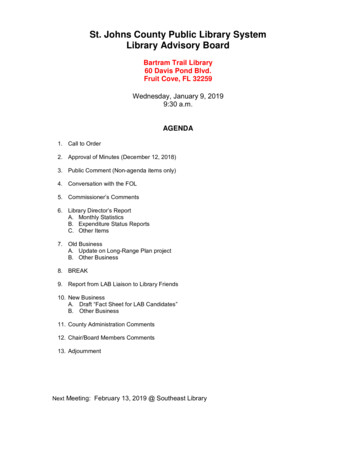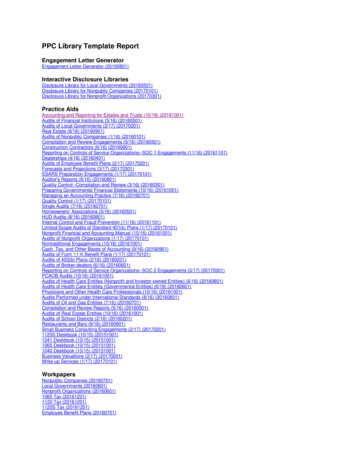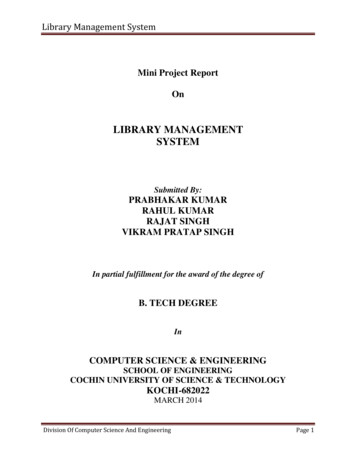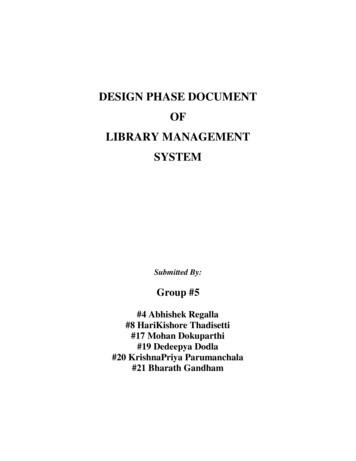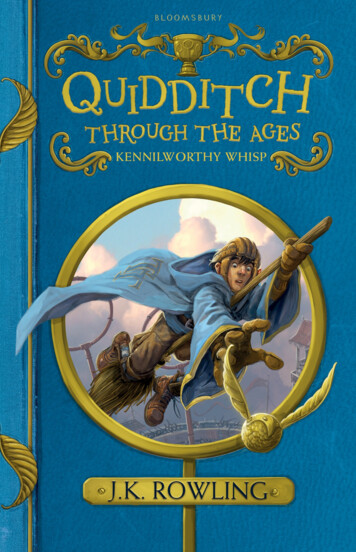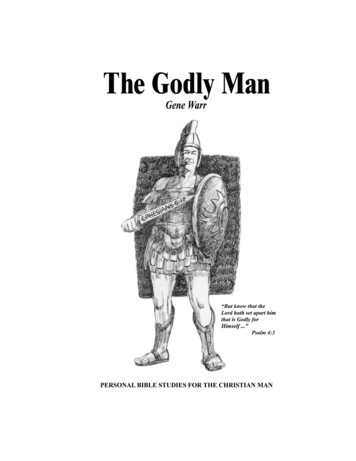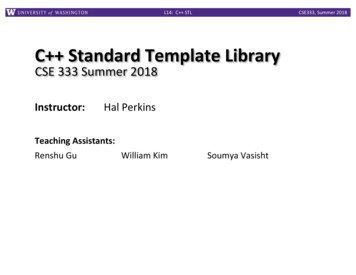
Transcription
L14: C STLCSE333, Summer 2018C Standard Template LibraryCSE 333 Summer 2018Instructor:Hal PerkinsTeaching Assistants:Renshu GuWilliam KimSoumya Vasisht
L14: C STLCSE333, Summer 2018C ’s Standard LibraryvC ’s Standard Library consists of four major pieces:1) The entire C standard library2) C ’s input/output stream library std::cin, std::cout, stringstreams, fstreams, etc.3) C ’s standard template library (STL) Containers, iterators, algorithms (sort, find, etc.), numerics4) C ’ ’s miscellaneous library Strings, exceptions, memory allocation, localization2
L14: C STLCSE333, Summer 2018STL Containers JvA container is an object that stores (in memory) acollection of other objects (elements)§ Implemented as class templates, so hugely flexible§ More info in C Primer §9.2, 11.2vSeveral different classes of container§ Sequence containers (vector, deque, list, .)§ Associative containers (set, map, multiset, multimap,bitset, .)§ Differ in algorithmic cost and supported operations3
L14: C STLCSE333, Summer 2018STL Containers LvSTL containers store by value, not by reference§ When you insert an object, the container makes a copy§ If the container needs to rearrange objects, it makes copies e.g. if you sort a vector, it will make many, many copies e.g. if you insert into a map, that may trigger several copies§ What if you don’t want this (disabled copy constructor or copyingis expensive)? You can insert a wrapper object with a pointer to the object– We’ll learn about these “smart pointers” soon4
L14: C STLCSE333, Summer 2018Our Tracer ClassvWrapper class for an unsigned int value§§§§Default ctor, cctor, dtor, op , op definedfriend function operator definedAlso holds unique unsigned int id (increasing from 0)Private helper method PrintID() to return"(id ,value )" as a string§ Class and member definitions can be found in Tracer.h andTracer.ccvUseful for tracing behaviors of containers§ All methods print identifying messages§ Unique id allows you to follow individual instances5
L14: C STLCSE333, Summer 2018STL vectorvA generic, dynamically resizable array§ or/§ Elements are store in contiguous memory locations Elements can be accessed using pointer arithmetic if you’d like to Random access is O(1) time§ Adding/removing from the end is cheap (amortized constanttime)§ Inserting/deleting from the middle or start is expensive (lineartime)6
L14: C STLvector/Tracer ExampleCSE333, Summer 2018vectorfun.cc#include iostream #include vector #include "Tracer.h"using namespace std;int main(int argc, char** argv) {Tracer a, b, c;vector Tracer vec;cout "vec.push back " a endl;vec.push back(a);cout "vec.push back " b endl;vec.push back(b);cout "vec.push back " c endl;vec.push back(c);cout "vec[0]" endl vec[0] endl;cout "vec[2]" endl vec[2] endl;return 0;}7
L14: C STLCSE333, Summer 2018STL iteratorvEach container class has an associated iterator class (e.g.vector int ::iterator) used to iterate throughelements of the container§ http://www.cplusplus.com/reference/std/iterator/§ Iterator range is from begin up to end end is one past the last container element!§ Some container iterators support more operations than others All can be incremented ( ), copied, copy-constructed Some can be dereferenced on RHS (e.g. x *it;) Some can be dereferenced on LHS (e.g. *it x;) Some can be decremented (--) Some support random access ([], , -, , - , , operators)9
L14: C STLiterator ExampleCSE333, Summer 2018vectoriterator.cc#include vector #include "Tracer.h"using namespace std;int main(int argc, char** argv) {Tracer a, b, c;vector Tracer vec;vec.push back(a);vec.push back(b);vec.push back(c);cout "Iterating:" endl;vector Tracer ::iterator it;for (it vec.begin(); it vec.end(); it ) {cout *it endl;}cout "Done iterating!" endl;return 0;}10
L14: C STLCSE333, Summer 2018Type Inference (C 11)vThe auto keyword can be used to infer types§ Simplifies your life if, for example, functions return complicatedtypes§ The expression using auto must contain explicit initialization forit to work// Calculate and return a vector// containing all factors of nstd::vector int Factors(int n);void foo(void) {// Manually identified typestd::vector int facts1 Factors(324234);// Inferred typeauto facts2 Factors(12321);// Compiler error hereauto facts3;}11
L14: C STLCSE333, Summer 2018auto and IteratorsvLife becomes much simpler!for (vector Tracer ::iterator it vec.begin(); it vec.end(); it ) {cout *it endl;}for (auto it vec.begin(); it vec.end(); it ) {cout *it endl;}12
L14: C STLCSE333, Summer 2018Range for Statement (C 11)vSyntactic sugar similar to Java’s foreach§forGeneralformat:( declaration: expression ) {statements}§ declaration defines loop variable§ expression is an object representing a sequence Strings, initializer lists, arrays with an explicit length defined, STLcontainers that support iterators// Prints out a string, one// character per linestd::string str("hello");for ( auto c : str ) {std::cout c std::endl;}13
L14: C STLUpdated iterator ExampleCSE333, Summer 2018vectoriterator 2011.cc#include vector #include "Tracer.h"using namespace std;int main(int argc, char** argv) {Tracer a, b, c;vector Tracer vec;vec.push back(a);vec.push back(b);vec.push back(c);cout "Iterating:" endl;// "auto" is a C 11 feature not available on older compilersfor (auto& p : vec) {cout p endl;}cout "Done iterating!" endl;return 0;}14
L14: C STLCSE333, Summer 2018STL AlgorithmsvA set of functions to be used on ranges of elements§ Range: any sequence that can be accessed through iterators orpointers, like arrays or some of the containers§ General form: algorithm(begin, end, .);vAlgorithms operate directly on range elements ratherthan the containers they live in§ Make use of elements’ copy ctor, , , ! , § Some do not modify elements e.g. find, count, for each, min element, binary search§ Some do modify elements e.g. sort, transform, copy, swap15
L14: C STLAlgorithms ExampleCSE333, Summer 2018vectoralgos.cc#include vector #include algorithm #include "Tracer.h"using namespace std;void PrintOut(const Tracer& p) {cout " printout: " p endl;}int main(int argc, char** argv) {Tracer a, b, c;vector Tracer vec;vec.push back(c);vec.push back(a);vec.push back(b);cout "sort:" endl;sort(vec.begin(), vec.end());cout "done sort!" endl;for each(vec.begin(), vec.end(), &PrintOut);return 0;}16
L14: C STLCSE333, Summer 2018STL listvA generic doubly-linked list§ http://www.cplusplus.com/reference/stl/list/§ Elements are not stored in contiguous memory locations Does not support random access (e.g. cannot do list[5])§ Some operations are much more efficient than vectors Constant time insertion, deletion anywhere in list Can iterate forward or backwards§ Has a built-in sort member function Doesn’t copy! Manipulates list structure instead of element values19
L14: C STLlist ExampleCSE333, Summer 2018listexample.cc#include list #include algorithm #include "Tracer.h"using namespace std;void PrintOut(const Tracer& p) {cout " printout: " p endl;}int main(int argc, char** argv) {Tracer a, b, c;list Tracer lst;lst.push back(c);lst.push back(a);lst.push back(b);cout "sort:" endl;lst.sort();cout "done sort!" endl;for each(lst.begin(), lst.end(), &PrintOut);return 0;}20
L14: C STLCSE333, Summer 2018STL mapvOne of C ’s associative containers: a key/value table,implemented as a tree§ http://www.cplusplus.com/reference/stl/map/§ General form: map key type, value type name;§ Keys must be unique multimap allows duplicate keys§ Efficient lookup (O(log n)) and insertion (O(log n)) Access value via name[key]§ Elements are type pair key type, value type and arestored in sorted order (key is field first, value is field second) Key type must support less-than operator ( )21
L14: C STLmap ExampleCSE333, Summer 2018mapexample.ccvoid PrintOut(const pair Tracer,Tracer & p) {cout "printout: [" p.first "," p.second "]" endl;}int main(int argc, char** argv) {Tracer a, b, c, d, e, f;map Tracer,Tracer table;map Tracer,Tracer ::iterator it;table.insert(pair Tracer,Tracer (a, b));table[c] d;table[e] f;cout "table[e]:" table[e] endl;it table.find(c);cout "PrintOut(*it), where it table.find(c)" endl;PrintOut(*it);cout "iterating:" endl;for each(table.begin(), table.end(), &PrintOut);return 0;}22
L14: C STLCSE333, Summer 2018Unordered Containers (C 11)vunordered map, unordered set§ And related classes unordered multimap,unordered multiset§ Average case for key access is O(1) But range iterators can be less efficient than ordered map/set§ See C Primer, online references for details23
L14: C STLCSE333, Summer 2018Extra Exercise #1vUsing the Tracer.h/.cc files from lecture:§ Construct a vector of lists of Tracers i.e. a vector container with each element being a list ofTracers§ Observe how many copies happen J Use the sort algorithm to sort the vector Use the list.sort() function to sort each list24
L14: C STLCSE333, Summer 2018Extra Exercise #2vTake one of the books from HW2’s test tree and:§ Read in the book, split it into words (you can use your hw2)§ For each word, insert the word into an STL map The key is the word, the value is an integer The value should keep track of how many times you’ve seen the word,so each time you encounter the word, increment its map element Thus, build a histogram of word count§ Print out the histogram in order, sorted by word count§ Bonus: Plot the histogram on a log-log scale (use Excel, gnuplot,etc.) x-axis: log(word number), y-axis: log(word count)25
L14: C STL CSE333, Summer 2018 STL Containers L vSTL containers store by value, not by reference §When you insert an object, the container makes a copy §If the container needs to rearrange objects, it makes copies e.g.if you sort a vector, it will make many, many copies e.g.if you insert into a map, that may trigge

